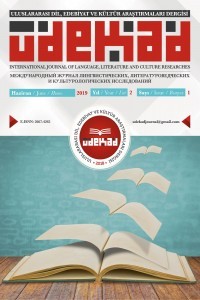House M.D. ve Sherlock Holmes: İmlemeli metinlerarası ögelerin analizi
Metinlerarasılık, metinler arasındaki ilişkiyi ifade eder ve hem benzer türlere sahip metinler arasında yatay olarak hem de farklı türlerdeki metinler arasında dikey olarak gözlemlenebilir. Bu çalışmada, Sherlock holmes hikâyeleri ve dünyaca tanınan televizyon dizisi House, M.D. üzerinde imleme odaklı bir dikey metinlerarasılık analizi amaçlanmıştır ve imlemeler fark et, takip et ve aşina ol adımları ile tespit edilmiş, açık ve kapalı göndermeler açısından gruplara ayrılmıştır. Çalışmanın sonuçları, House, M.D. dizisinin çok sayıda imleme içeren bir metin olduğuna işaret etmekte ve kullanılan imlemelerin bu uzun soluklu dizinin başarısına katkıda bulunduğu düşünülmektedir. Her iki eserin de hedef kitlesi göz önüne alındığında, bu imlemeleri fark etmenin izleyici için eğlenceli bir aktivite olabileceği ve dizi için belirli bir izleyici kitlesini garanti edebileceği düşünülebilir. Bu bağlamda, imlemeli metinler arası ögeler yalnızca biçimsel araçlar olarak değil, aynı zamanda imleme içeren metin için aşinalık ve tanınma sağlayan araçlar olarak da değerlendirilebilir.
Anahtar Kelimeler:
Metinlerarasılık, House M.D., Sherlock Holmes, İmleme, Metinlerarası ögeler
House M.D. and Sherlock Holmes: An analysis of allusive intertextual elements
Intertextuality refers to the relationship among texts and can be observed both horizontally between the texts of similar genres and vertically between the texts of different genres. This relationship can be built through several literary devices, one of which is allusion. In this study, a vertical intertextual analysis was aimed at in the texts of Arthur Conan Doyle’s Sherlock Holmes stories and the world-famous TV series House, M.D. with a special focus on allusions. These elements were detected by three steps offered by Montgomery et al. (2007): notice, track, and become familiar. Then they were categorized in terms of explicit and implicit references. The results of the study point out that the House M.D. series is a highly allusive text, and it is thought that the allusions contribute to the success of this long-running series. Considering the target audience of both works, it can be thought that recognizing these allusions can be an enjoyable activity for the audience and guarantee a certain audience for the series. In this context, allusive intertextual elements can be considered not only as stylistic tools, but also as tools that provide familiarity and recognition for the alluded text.
Keywords:
Intertextuality, House M.D., Sherlock Holmes, Allusion, Intertextual elements,
___
- Allen, G. (2000). Intertextuality. Routledge.
- Barthes, R. (1977). Image – music – text. Fontana.
- Barthes, R. (1981). Theory of the text. In R. Young (ed.), ( pp. 31-47). Untying the text. Routledge.
- Brian, H. (2008). A star comes to Huddersfield!. BBC. Retrieved 11 June 2021 from http://www.bbc.co.uk/bradford/content/articles/2007/02/27/sherlock_holmes_huddersfield_feature.shtml
- Conner, K. (2006). Allusive mechanics in modern and post modern fiction as suggested by James Joyce in his novel Dubliners. [Doctoral dissertation, University of Nabraska] http:// digitalcommons.unl.edu/englishdiss.
- Fairclough, N. (1992). Discourse and social change. Cambridge: Polity.
- Guinness World Records. (2012)."Sherlock Holmes awarded title for most portrayed literary human character in film & TV. Retrieved 10 March 2021 from https://www.guinnessworldrecords.com/news/2012/5/sherlock-holmes-awarded-title-for-most-portrayed-literary-human-character-in-film-tv-41743
- Hatim, B. (1997). Intertextual intrusions: towards a framework for harnessing the power of the absent text in translation. In Simms, K. (ed.), (pp. 29-46). Translating sensitive texts: Linguistic aspects. Rodopi.
- Huffpost (2009). House’ Becomes World’s Most Popular TV Show. Retrieved 11 June 2021 from https://www.huffpost.com/entry/house-becomes-worlds-most_n_214704
- Kristeva, J. (1980). Desire in language: A semiotic approach to literature and art. Columbia University Press.
- Kristeva, J.(1986). Word, dialogue, and the novel. Columbia University Press.
- Montgomery, M., Durant, A., Fabb, N., Furniss, T., & Mills, S. (2007). Ways of reading. Routledge.
- Morris, P. (2009). The Bakhtin reader. Bloomsbury Academic.
- Pasnik, M. (2014). Intertextual adaptability of the character of Sherlock Holmes from literature to film production. Analyses/rereadings/theories: A Journal Devoted to Literature, Film and Theatre, 2 (1), 35-40.
- Rowland, S. (2011). House not Ho(l)mes. In L. Hockley and L. Gardner (eds), House: The wounded healer on television (pp. 133–151). Routledge.
- Steiff, J. (2011). Sherlock Holmes and philosophy: The footprints of a gigantic mind. Open Court.
- Başlangıç: 2018
- Yayıncı: Reşat ŞAKAR
Sayıdaki Diğer Makaleler
“Dil Hırsızları”: Anne Finch ve Lady Mary Montagu
Çin Dili ve Yazılı Çeviri Tarihine Genel Bir Bakış
House M.D. ve Sherlock Holmes: İmlemeli metinlerarası ögelerin analizi
TÜRK VE RUS EDEBİYATLARINDA İLK ÜTOPİK RÜYALAR
LÂMİ’Î ÇELEBİ'NİN SALÂMÂN VE ABSÂL MESNEVİSİNİN TASAVVUFİ BİR DEĞERLENDİRMESİ
ÇOKKÜLTÜRLÜLÜK VE ÇOKDİLLİLİK BAĞLAMINDA MİDYAT
Hadra Kübra ERKINAY TAMTAMIŞ, Abdulhalim AYDOĞAN
Coetzee’nin Foe ve Kulin’in Handan Romanlarına Metinlerarası Bir Yaklaşım
TEMAS HİPOTEZİ BAĞLAMINDA ULUSLARARASI ÖĞRENCİLERİN KÜLTÜREL TUTUMLARINI ANLAMLANDIRMAK
Ömer Faruk KOÇAK, Mustafa TEMEL
DİL-KÜLTÜR ETKİLEŞİM ÖRNEĞİ OLARAK RUSÇADA SAATLERİN İFADESİ
